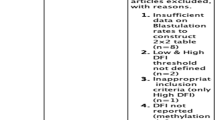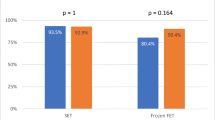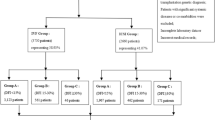Abstract
Purpose
The purpose of this study was to carry out a meta-analysis for a comprehensive understanding and estimation of the association between sperm DNA Fragmentation Index (DFI) and pregnancy outcome after in vitro fertilization (IVF) or intracytoplasmic sperm injection (ICSI) treatment.
Methods
Studies concerning the link of DFI with pregnancy outcome were included after literature search of database PUBMED, EMBASE, MEDLINE. Related information was extracted from the eligible studies by two independent authors and a meta-analysis was conducted by using STATA 12.0 software. Pregnancy outcomes consisted of biochemical pregnancy (BP), clinical pregnancy (CP) and pregnancy loss (PL). The studies included for meta-analysis were divided into three groups according to the DFI threshold value (DFI >27 %, 15–27 %, ≤15 % group). The odds ratio (OR ) and their 95 % confidence intervals (95 % CIs) were used to evaluate the association between DFI and pregnancy outcome.
Results
Twenty articles were included in our meta-analysis. The results indicated that infertile couples were more likely to get pregnant if DFI was less than threshold value (For threshold value > 27 % and 15–27 % group, combined overall OR (95 % CI) = 1.437 (1.186–1.742), 1.639 (1.093–2.459) respectively). However, when stratified by DFI detection methods, using sperm chromatin structure assay (SCSA) as the DFI test method, the results indicated a similar CP rate between groups with a high DFI or a lower DFI value (SCSA, For threshold value >27 % and 15–27 % group, combined overall OR (95 % CI) = 1.242(0.978–1.577), 1.480(0.921–2.377) respectively). The meta-analysis based on BP (overall OR (95 % CI) = 0.952 (0.697–1.302)) and PL((For DFI >27 %, 15–27 %, ≤15 % group, OR (95 % CI) = 0.786 (0.491–1.258), 1.509 (0.655–3.476), (0.538 (0.264–1.097) respectively) outcome yielded nonsignificant results.
Conclusions
The predication value of DFI for IVF or ICSI outcome is not confirmed in our meta-analysis. Further better designed studies with larger subjects involved are needed to better address this issue.






Similar content being viewed by others
References
Katz P, Nachtigall R, Showstack J. The economic impact of the assisted reproductive technologies. Nat Cell Biol. 2002;4:29–32.
Agarwal A, Allamaneni SS. The effect of sperm DNA damage on assisted reproduction outcomes. A review. Minerva Ginecol. 2004;56:235–45.
Shamsi MB, Kumar R, Dada R. Evaluation of nuclear DNA damage in human spermatozoa in men opting for assisted reproduction. Indian J Med Res. 2008;127:115–23.
Evenson D, Wixon R. Meta-analysis of sperm DNA fragmentation using the sperm chromatin structure assay. Reprod Biomed Online. 2006;12:466–72.
Collins JA, Barnhart KT, Schlegel PN. Do sperm DNA integrity tests predict pregnancy with in vitro fertilization? Fertil Steril. 2008;89:823–31.
Stang A. Critical evaluation of the Newcastle-Ottawa scale for the assessment of the quality of nonrandomized studies in meta-analyses. Eur J Epidemiol. 2010;25:603–5.
Benchaib M, Lornage J, Mazoyer C, Lejeune H, Salle B, François GJ. Sperm deoxyribonucleic acid fragmentation as a prognostic indicator of assisted reproductive technology outcome. Fertil Steril. 2007;87:93–100.
Boe-Hansen GB, Fedder J, Ersbøll AK, Christensen P. The sperm chromatin structure assay as a diagnostic tool in the human fertility clinic. Hum Reprod. 2006;21:1576–82.
Bungum M, Humaidan P, Spano M, Jepson K, Bungum L, Giwercman A. The predictive value of sperm chromatin structure assay (SCSA) parameters for the outcome of intrauterine insemination, IVF and ICSI. Hum Reprod. 2004;19:1401–8.
Bungum M, Humaidan P, Axmon A, Spano M, Bungum L, Erenpreiss J, et al. Sperm DNA integrity assessment in prediction of assisted reproduction technology outcome. Hum Reprod. 2007;22:174–9.
Bungum M, Spanò M, Humaidan P, Eleuteri P, Rescia M, Giwercman A. Sperm chromatin structure assay parameters measured after density gradient centrifugation are not predictive for the outcome of ART. Hum Reprod. 2008;23:4–10.
Chi HJ, Chung DY, Choi SY, Kim JH, Kim GY, Lee JS, et al. Integrity of human sperm DNA assessed by the neutral comet assay and its relationship to semen parameters and clinical outcomes for the IVF-ET program. Clin Exp Reprod Med. 2011;38:10–7.
Gandini L, Lombardo F, Paoli D, Caruso F, Eleuteri P, Leter G, et al. Full-term pregnancies achieved with ICSI despite high levels of sperm chromatin damage. Hum Reprod. 2004;19:1409–17.
Kennedy C, Ahlering P, Rodriguez H, Levy S, Sutovsky P. Sperm chromatin structure correlates with spontaneous abortion and multiple pregnancy rates in assisted reproduction. Reprod Biomed Online. 2011;22:272–6.
Lin MH, Kuo-Kuang Lee R, Li SH, Lu CH, Sun FJ, et al. Sperm chromatin structure assay parameters are not related to fertilization rates, embryo quality, and pregnancy rates in in vitro fertilization and intracytoplasmic sperm injection, but might be related to spontaneous abortion rates. Fertil Steril. 2008;90:352–9.
Miciński P, Pawlicki K, Wielgus E, Bochenek M, Tworkowska I. The sperm chromatin structure assay (SCSA) as prognostic factor in IVF/ICSI program. Reprod Biol. 2009;9:65–70.
Niu ZH, Shi HJ, Zhang HQ, Zhang AJ, Sun YJ, Feng Y. Sperm chromatin structure assay results after swim-up are related only to embryo quality but not to fertilization and pregnancy rates following IVF. s. 2011;13:862–6.
Payne JF, Raburn DJ, Couchman GM, Price TM, Jamison MG, Walmer DK. Redefining the relationship between sperm deoxyribonucleic acid fragmentation as measured by the sperm chromatin structure assay and outcomes of assisted reproductive techniques. Fertil Steril. 2005;84:356–64.
Henkel R, Kierspel E, Hajimohammad M, Stalf T, Hoogendijk C, Mehnert C, et al. DNA fragmentation of spermatozoa and assisted reproduction technology. Reprod Biomed Online. 2003;7:477–84.
Henkel R, Hajimohammad M, Stalf T, Hoogendijk C, Mehnert C, Menkveld R, et al. Influence of deoxyribonucleic acid damage on fertilization and pregnancy. Fertil Steril. 2004;81:965–72.
Zhang Y, Wang H, Wang L, Zhou Z, Sha J, Mao Y, et al. The clinical significance of sperm DNA damage detection combined with routine semen testing in assisted reproduction. Mol Med Rep. 2008;1:617–24.
Zini A, Meriano J, Kader K, Jarvi K, Laskin CA, Cadesky K. Potential adverse effect of sperm DNA damage on embryo quality after ICSI. Hum Reprod. 2005;20:3476–80.
Dar S, Grover SA, Moskovtsev SI, Swanson S, Baratz A, Librach CL. In vitro fertilization-intracytoplasmic sperm injection outcome in patients with a markedly high DNA fragmentation index (>50 %). Fertil Steril. 2013;100:75–80.
Speyer BE, Pizzey AR, Ranieri M, Joshi R, Delhanty JD, Serhal P. Fall in implantation rates following ICSI with sperm with high DNA fragmentation. Hum Reprod. 2010;25:1609–18.
Jiang HH, He XJ, Song B, Cao YX. Sperm chromatin integrity test for predicting the outcomes of IVF and ICSI. Zhonghua Nan Ke Xue. 2011;17:1083–6.
Yang XY, Wang LL, Chen P, Zhang Y, Zhang W, Cui YG, et al. Impact of sperm DNA fragmentation index and sperm malformation rate on the clinical outcome of ICSI. Zhonghua Nan Ke Xue. 2013;19:1082–6.
Venkatesh S, Singh A, Shamsi MB, Thilagavathi J, Kumar R, Mitra DK, et al. Clinical significance of sperm DNA damage threshold value in the assessment of male infertility. Reprod Sci. 2011;18:1005–13.
Van Kooij RJ, de Boer P, De Vreeden-Elbertse JM, Ganga NA, Singh N, Te Velde ER. The neutral comet assay detects double strand DNA damage in selected and unselected human spermatozoa of normospermic donors. Int J Androl. 2004;27:140–6.
Acknowledgments
The study was supported by the National Natural Science Foundation of China (No. 81170563 and 81270694).
Conflict of interest
All authors declare no competing financial interests.
Author information
Authors and Affiliations
Corresponding author
Additional information
Capsule DFI is an important value to assess human sperm quality, but this meta-analysis found no association between DFI and pregnancy outcome after IVF or ICSI.
Rights and permissions
About this article
Cite this article
Zhang, Z., Zhu, L., Jiang, H. et al. Sperm DNA fragmentation index and pregnancy outcome after IVF or ICSI: a meta-analysis. J Assist Reprod Genet 32, 17–26 (2015). https://doi.org/10.1007/s10815-014-0374-1
Received:
Accepted:
Published:
Issue Date:
DOI: https://doi.org/10.1007/s10815-014-0374-1




